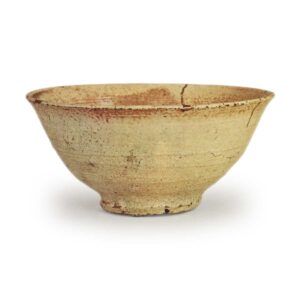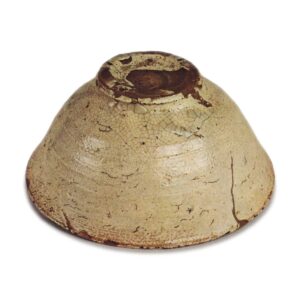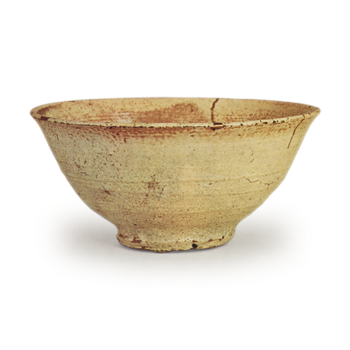

Height: 6.7 to 6.9 cm
Diameter: 14.0 to 14.5 cm
Outer diameter of foot ring: 5.3 to 5.5 cm
Height: 1.0 cm
It is not clear when the name “Ido-waki” was first used. However, as far as I can tell, the earliest reference to it is in the “Unshu Meibutsu-ki” (“Famous Products of Unshu”), which mentions “Ido-waki Ariake”. Before that, it is not mentioned in tea ceremony records from the early Edo period, or in the “Kanko Meibutsu-ki” (“Famous Products of Kanko”), “Enshu Gokuramoto-cho” (“Enshu Storehouse Ledger”), or even in the “Kokin Meibutsu Ruiju” (“Collection of Famous Products from Ancient and Modern Times”). However, in the Meiji era, in the “Nagasaki Ido Waki” section of Toda Rogen’s “Gogaku-shu” (“Collected Works of Later Students”), it is written that “In Tokyo, since ancient times, there was a well known as Koido, and it was Soshio who first called it Ido Waki, and from this, his name became famous”. Leaving aside the question of whether this is true or not, since the date of composition of the “Unshu Meibutsu Ki” and the period of Socho’s life are roughly the same, it is probably not wrong to assume that the name “Ido-waki” came to be used for a type of well that had been called “Koido” since the time of Lord Fumai.
By the way, in the “Famous Products Discriminating Book”, it says, “The thing called ‘well-side’ is similar to a well, but it is not as good as a well. However, there are many different kinds, some of which have a tortoise-shaped pattern, and some of which are of poor quality. The wood (the base material) is also noisier than a well is more noisy than a well, and the name Ido-waki is a reference to the noise, so what is there to say about it?” As you can see from this, the characteristics of Ido-waki tea bowls were rather vague at first.
Therefore, the Ido-waki tea bowl is not something that has a fixed characteristic, and the Nagasaki, Hakubai, and Daibizan in this volume each have a different feel.
This Ido-waki, which is named Hakubai, is different from Nagasaki in that the glaze that covers the entire surface is, at first glance, Ido-style, but it is not loquat-colored, and the glaze that shows a bluish hue in some places . The glaze, which is almost white, is slightly grey and finely textured, and the clay seems to have been fired hard. The shape, from the rim to the low foot ring with a bamboo-joint shape, is similar to that of a small well, but the glaze and clay are different, so the overall impression is quite different from that of a well, and it really gives the feeling of “something that looks like a well but is not as good as one”. However, it is certainly not considered to be of such poor quality, and it can still be said to be a representative and excellent work of this type of tea bowl.
The origin of this tea bowl is not clear, but the accompanying note says, “In the past, this tea bowl was used by a nobleman named Mouri, who was a great fan of the tea ceremony. One day, he was invited to a tea ceremony, and when he put it in his mouth, he said, ‘This is not something that should be used by a nobleman. and so it was received as it was, and it is said that it became famous in the world as the well-worn tea bowl of Rakuzen. The characters “Ido-waki chawan” on the box are similar to the handwriting of Matsudaira Fumai, but it is thought that they were written by someone who admired Fumai’s style of calligraphy in later generations, and the author is not identified in the “Taisho Meiki Kan” either. Around the beginning of the Taisho era, it was owned by Kato Masayoshi.



